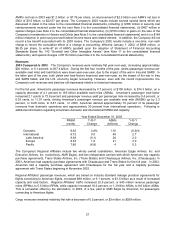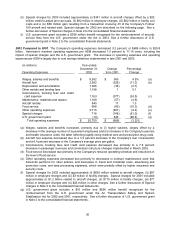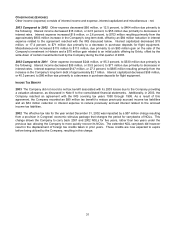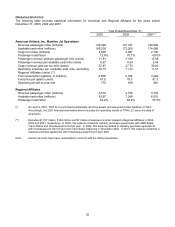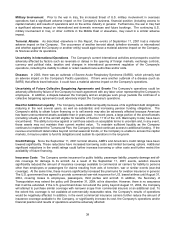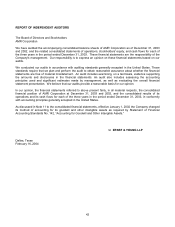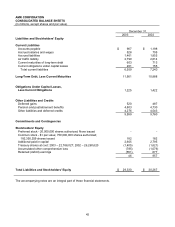American Airlines 2003 Annual Report Download - page 38
Download and view the complete annual report
Please find page 38 of the 2003 American Airlines annual report below. You can navigate through the pages in the report by either clicking on the pages listed below, or by using the keyword search tool below to find specific information within the annual report.
36
Income taxes – The Company accounts for income taxes in accordance with Financial Accounting
Standards No. 109, “Accounting for Income Taxes”. Accordingly, the Company records a deferred tax asset
valuation allowance when it is more likely than not that some portion or all of its deferred tax assets will not
be realized. The Company considers its historical earnings, trends, and outlook for future years in making
this determination. The Company has a deferred tax valuation allowance of $663 million as of December 31,
2003. See Note 8 to the consolidated financial statements for additional information.
Tax contingencies – The Company has reserves for taxes and associated interest that may become payable
in future years as a result of audits by tax authorities. Although the Company believes that the positions
taken on previously filed tax returns are appropriate, it nevertheless has established tax and interest
reserves in recognition that various taxing authorities may challenge the positions taken by the Company
resulting in additional liabilities for taxes and interest. The tax reserves are reviewed as circumstances
warrant and adjusted as events occur that affect the Company’s potential liability for additional taxes, such
as lapsing of applicable statutes of limitations, conclusion of tax audits, additional exposure based on
current calculations, identification of new issues, release of administrative guidance, or rendering of a court
decision affecting a particular tax issue. In 2003, the Company reached an agreement with the IRS covering
tax years 1990 through 1995 and as a result, recorded an $80 million tax benefit to reduce previously
accrued income tax liabilities and an $84 million reduction in interest expense to reduce previously accrued
interest related to accrued tax liabilities.
Risk Factors
The Company’s ability to return to sustained profitability will depend on a number of risk factors, many of which are
largely beyond the Company’s control. Among other things, the following factors have had and/or may have a
negative impact on the Company’s business and financial results:
Economic and Other Conditions The airline industry is affected by changes in international, national, regional
and local economic, business and financial conditions, inflation, war, terrorist attacks, political instability (or the
threat thereof), consumer preferences and spending patterns, demographic trends, disruptions to the air traffic
control system, consumer perceptions of airline safety, costs of safety, security and environmental measures, and
the weather.
Substantial Indebtedness The Company has, and will continue to have, a significant amount of indebtedness.
In addition, the Company, American and their respective subsidiaries may incur substantial additional debt,
including secured debt, in the future. As discussed earlier in this Report, the Company’s substantial indebtedness
could have important consequences. For example, it could (i) limit the Company’s ability to obtain additional
financing for working capital, capital expenditures, acquisitions and general corporate purposes, (ii) require the
Company to dedicate a substantial portion of its cash flow from operations to payments on its indebtedness,
thereby reducing the funds available for other purposes, (iii) make the Company more vulnerable to economic
downturns, (iv) limit its ability to withstand competitive pressures and reduce its flexibility in responding to changing
business and economic conditions and, (v) limit the Company’s flexibility in planning for, or reacting to, changes in
its business and the industry in which it operates.
Credit Facility Covenants American has a fully drawn $834 million bank credit facility that expires December 15,
2005, which contains a liquidity covenant and an EBITDAR (generally, earnings before interest, taxes,
depreciation, amortization and rentals, adjusted for certain non-cash items) to fixed charges (generally, interest
and total rentals) ratio covenant. The Company expects to be able to continue to comply with these covenants.
However, it cannot be sure that it will continue to be able to do so through the expiration of the facility. Failure to do
so would result in a default under this facility and a significant amount of American’s other debt.
Fuel Prices / Supply Due to the competitive nature of the airline industry, in the event of continuing increases in
the price of jet fuel, there can be no assurance that the Company will be able to pass on increased fuel prices to its
customers by increasing its fares. Likewise, increased fare competition and lower revenues for all air carriers may
offset any potential benefit of lower fuel prices. As of December 31, 2003, the Company had hedged approximately
21 percent of its expected first quarter 2004 fuel requirements, and a much lower percentage of its expected fuel
requirements beyond March 31, 2004.



